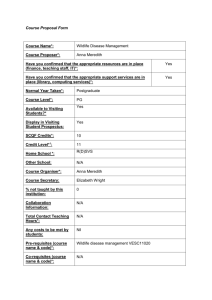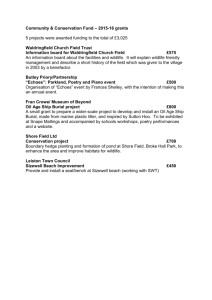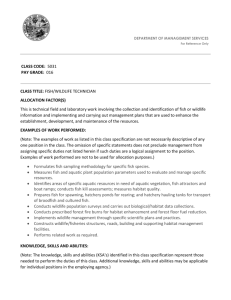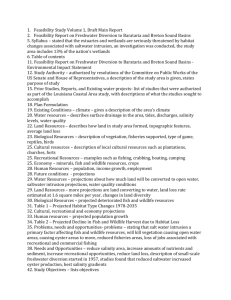Management Effectiveness of State Fish and Wildlife Agencies
advertisement
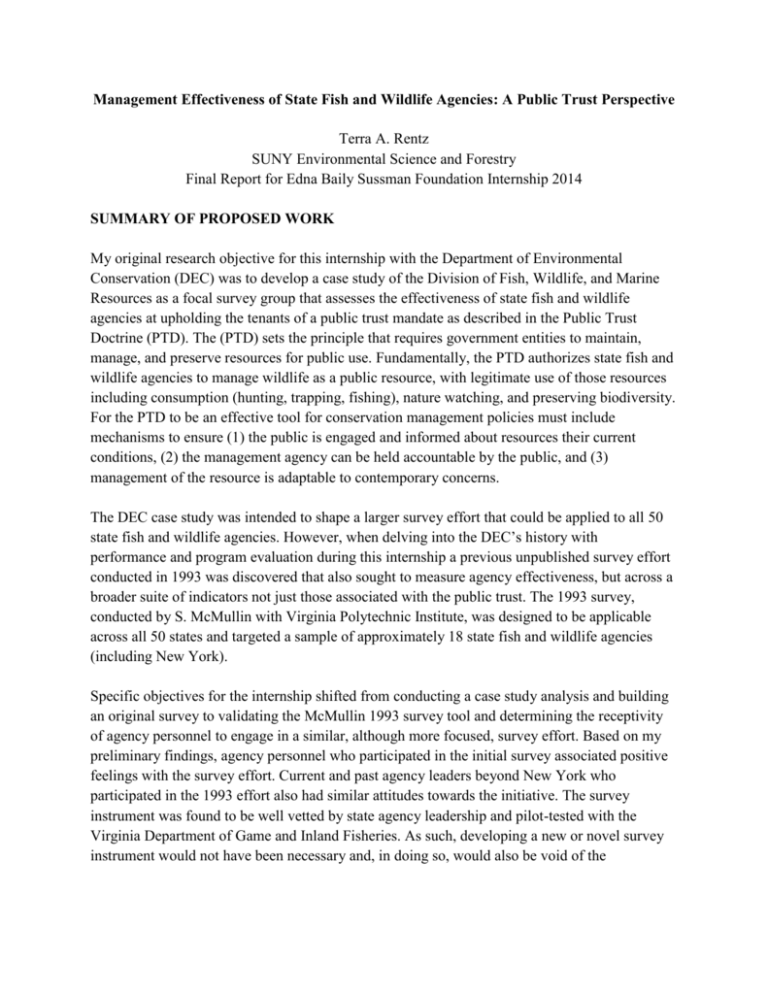
Management Effectiveness of State Fish and Wildlife Agencies: A Public Trust Perspective Terra A. Rentz SUNY Environmental Science and Forestry Final Report for Edna Baily Sussman Foundation Internship 2014 SUMMARY OF PROPOSED WORK My original research objective for this internship with the Department of Environmental Conservation (DEC) was to develop a case study of the Division of Fish, Wildlife, and Marine Resources as a focal survey group that assesses the effectiveness of state fish and wildlife agencies at upholding the tenants of a public trust mandate as described in the Public Trust Doctrine (PTD). The (PTD) sets the principle that requires government entities to maintain, manage, and preserve resources for public use. Fundamentally, the PTD authorizes state fish and wildlife agencies to manage wildlife as a public resource, with legitimate use of those resources including consumption (hunting, trapping, fishing), nature watching, and preserving biodiversity. For the PTD to be an effective tool for conservation management policies must include mechanisms to ensure (1) the public is engaged and informed about resources their current conditions, (2) the management agency can be held accountable by the public, and (3) management of the resource is adaptable to contemporary concerns. The DEC case study was intended to shape a larger survey effort that could be applied to all 50 state fish and wildlife agencies. However, when delving into the DEC’s history with performance and program evaluation during this internship a previous unpublished survey effort conducted in 1993 was discovered that also sought to measure agency effectiveness, but across a broader suite of indicators not just those associated with the public trust. The 1993 survey, conducted by S. McMullin with Virginia Polytechnic Institute, was designed to be applicable across all 50 states and targeted a sample of approximately 18 state fish and wildlife agencies (including New York). Specific objectives for the internship shifted from conducting a case study analysis and building an original survey to validating the McMullin 1993 survey tool and determining the receptivity of agency personnel to engage in a similar, although more focused, survey effort. Based on my preliminary findings, agency personnel who participated in the initial survey associated positive feelings with the survey effort. Current and past agency leaders beyond New York who participated in the 1993 effort also had similar attitudes towards the initiative. The survey instrument was found to be well vetted by state agency leadership and pilot-tested with the Virginia Department of Game and Inland Fisheries. As such, developing a new or novel survey instrument would not have been necessary and, in doing so, would also be void of the opportunity to compare changes in state agencies over time. Thus, my research objectives changed accordingly. My goal of this internship remained to evaluate the effectiveness of state fish and wildlife agencies with respect to upholding public trust principles. A contemporary evaluation of agency effectiveness remains warranted given broadening agency mandates, changing fiscal resources, and increased stakeholder diversity. My current objectives for this research are to (1) re-evaluate McMullin’s data from 18 states to elucidate patterns in the socio-political, spatio-temporal, fiscal, and institutional barriers to management effectiveness; (2) use a subset of the original survey instrument to compare contemporary perceptions of agency effectiveness through a public trust lens to identify how agencies may have changed over time; and (3) identify opportunities that effective agencies pursue to meet public trust responsibilities. Contemporary perceptions of agency effectiveness will be measured through the use of mixed-mode survey research. In addition, opportunities will be evaluated through the use case-study analyses of those states that that score particularly high in a given area. WORK COMPLETED Between May and July 2014, I conducted an in-depth review and evaluation of program evaluation techniques for organizational management. Few studies have applied modern program evaluation methods to natural resource agencies. As such, it was critical to develop a clear structure of analyses that could be integrated into my survey instrument that was in line with modern corporate and organizational effectiveness theories. Scoping interviews were conducted in-person and over the phone with current and past state and federal agency leaders both within and outside New York to assess the receptivity of agency personnel to previous and future survey efforts. I also used these interviews to identify strengths and weaknesses from the McMullin survey in an effort to improve delivery and participation by agency personnel. Initial buy-in and support for future survey efforts was also secured from agency leadership in 4 of the original 18 states surveyed. The McMullin survey effort reinforced my hypotheses regarding the role prioritization, stakeholder engagements, budget allocation and transparency, and management planning play in driving organizational effectiveness. Discovery of the McMullin survey effort and the aforementioned literature review and scoping interviews resulted in a completely redesigned research proposal develop between July and August 2014 that more efficiently and effectively addresses my research objectives. A set of standardized survey questions and measures has been modified from McMullin’s survey instrument and can be applied to all 50 state agencies. FUTURE WORK This summer provided the fundamental opportunity for scoping, development, and validation of my survey instrument and refinement of my research objectives. In spring 2015 I plan to secure approval from the Institutional Review Board and will conduct my survey of state agencies selected from the original 18 states surveyed by McMullin. On-line surveys will be made available to respondents in late spring/early summer with follow-up telephone surveys occurring in Fall 2015. Data from surveys will be evaluated in winter 2015/spring 2016. Original survey data from 1993 will be secured and evaluated in summer/fall 2015 to identify trends or patterns that distinguish state agencies historically. These patterns will be compared to contemporary survey results and used to illuminate barriers or opportunities that agencies have faced over the past 20 years. Finally, using the survey data an evaluation of performance through the lens the PTD will be conducted to determine the degree to which agencies are addressing public trust tenants in their general operations. Case studies will be developed that highlight opportunities agencies have pursued to maximize effectiveness in meeting public trust obligations. Results and findings will be presented at a variety of venues including The Wildlife Society’s annual conference, the North American Wildlife and Natural Resources conference, and the Northeast Association of Fish and Wildlife Agencies annual meeting. ACKNOWLEDGEMENTS I am appreciative of my advisor, Dr. Jacqueline Frair and my supervisor, Gordon Batcheller (NY DEC) for their support and guidance throughout this internship. Conducting any review of state fish and wildlife agencies is a delicate process as the goal is to be constructive and additive, not controversial - their advice and enthusiasm has been invaluable. I am also greatly appreciative of my other committee members, Drs. Daniel Decker and Andrea Parker, who continue to work with me as I refine my social survey skills and techniques. Finally, I am forever grateful to the Edna Baily Sussman Foundation and council members for supporting this research and the council’s willingness to consider a human dimensions research project. The Foundation will be clearly acknowledged on all publications and presentations resulting from this research.



